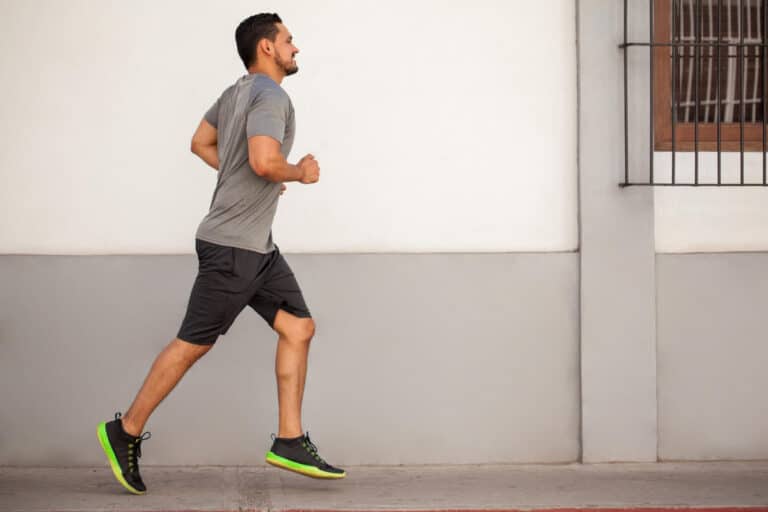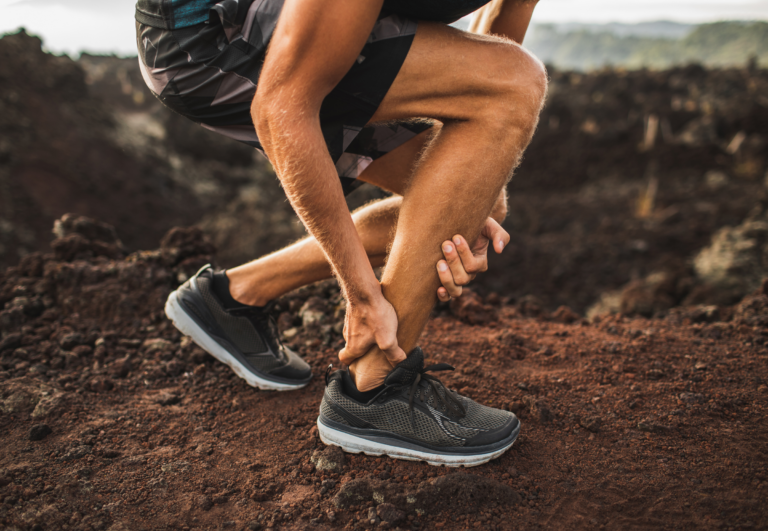How to Activate Hamstrings Before Running – Key Routine, Exercises, and Stretches!
Activating your hamstrings properly before a run is essential for a powerful stride and injury prevention. Your hamstrings play a critical role in running as they help drive you forward and provide stability.
To ensure they’re ready for the demands of running, begin with dynamic exercises that mimic running movements. This warms them up effectively, increasing flexibility and reducing the risk of strains or pulls.

Incorporate movements that isolate the hamstrings, engaging them more intensively to ‘wake them up.’ Start with no weights to assess your hamstring’s tolerance and then, if comfortable, progress to light weights.
This step-by-step approach not only activates the muscles but also builds strength over time, contributing to better running performance and endurance.
Best Hamstring Activation Routine for Runners
An effective hamstring activation routine for runners should include exercises that target the hamstrings directly, promoting strength and flexibility.
Here’s a specific routine with exercises, reps, and the time required for each:
- Dynamic Leg Swings (2 minutes): Stand on one leg and swing the other leg forward and backward, gradually increasing the range of motion. Perform for 1 minute on each leg.
- Single Leg Bridge (2 sets of 8 reps per leg, 3 minutes): Lie on your back with one leg bent and the other extended straight up. Push through the heel of the bent leg to lift your hips, then lower back down. Alternate after each set.
- Nordic Hamstring Curls (2 sets of 5 reps, 3 minutes): Kneel on the ground with your heels secured. Slowly lower yourself forward, using your hamstrings to control the descent, then push back up to the starting position.
- Hamstring Walkouts (2 sets of 6 reps, 3 minutes): Start in a bridge position and slowly walk your feet out to straighten your legs, then walk them back in, maintaining raised hips throughout the movement.
- Standing Leg Curls (2 sets of 10 reps per leg, 4 minutes): Use a resistance band or body weight. Stand and curl one heel toward your glutes, then lower back down with control. Alternate after each set.
This routine targets the hamstrings with both unilateral and bilateral movements, emphasizing control and quality to effectively prepare the muscles for running. Remember to maintain proper form and to not rush through the exercises to ensure optimal activation.
Personalization: Tailoring Your Hamstring Activation to Your Running Style and Condition
Every runner is unique, and so are their training needs. Personalizing your hamstring activation routine can lead to better performance and reduce the risk of injury.
Here are some tips on how to customize the routine based on individual needs:
For Sprinters
Sprinting requires powerful and explosive movements, so hamstring activation should focus on exercises that enhance these qualities.
Incorporating plyometric exercises like jump squats or box jumps after the initial activation can prime the muscles for the explosive efforts required in sprinting. Sprinters may also benefit from shorter, more intense dynamic stretches and activation exercises to mirror the high-intensity demands of their sport.
For Distance Runners
Endurance runners need to activate their hamstrings for sustained periods. Therefore, their activation routine should include exercises that emphasize control and endurance.
This could involve increasing the reps or duration of the dynamic leg swings and bridges, or incorporating a longer low-intensity jog as part of the warm-up. Static stretches can also be gently included post-activation to improve flexibility, as long as they’re not overdone before the run.
For Those Recovering from Hamstring Injuries
If you’re returning from a hamstring injury, your focus should be on gentle activation that does not strain the recovering muscles. Begin with very light dynamic movements and pay close attention to any discomfort.
Avoid high-intensity or plyometric exercises until the hamstring has fully healed. It’s crucial to consult with a healthcare professional or a physical therapist to tailor the routine to your specific stage of recovery.
General Personalization Tips:
- Listen to Your Body: Adjust the intensity and volume of exercises based on how your body feels. If you experience any pain or discomfort, scale back and focus on gentle movements.
- Warm-Up Duration: Depending on your individual needs and the time available, you may shorten or extend the warm-up. Just ensure that you’re sufficiently activating the hamstrings without over-fatiguing them before your run.
- Progressive Overload: As you get stronger and more comfortable with the routine, gradually increase the difficulty to continue making gains in strength and flexibility.
- Balance and Stability: If balance is a challenge, include exercises like single-leg Romanian deadlifts that promote stability and hamstring engagement.
- Incorporate Feedback: After each run, reflect on how your hamstrings felt during and after the workout. Use this feedback to adjust your routine accordingly.
Hamstring Anatomy and Its Role in Running
The hamstring muscles are crucial for your running performance, as they are involved in powerful leg movements. Maintaining their strength and preventing injuries ensures that you can run effectively and without pain.
Importance of Hamstring Strength for Runners
Your hamstrings are a trio of muscles located at the back of your thigh that are essential for running. They work tirelessly to flex your knee and extend your hip, which propels you forward with each stride.
To optimize your runs, your hamstrings must be strong and flexible. Weak hamstrings can lead to poor running mechanics, which can decrease your efficiency and performance.
Exercises to Strengthen Your Hamstrings:
- Hamstring curls
- Deadlifts
- Bridges
- Romanian deadlifts
Common Hamstring Injuries and Prevention for Runners
Hamstring injuries, including strains and tears, are common among runners and can sideline you from your training.
To prevent injury, incorporate regular stretching and strengthening routines into your workout schedule. Warming up before running increases blood flow, enhancing your muscles’ elasticity and function.
Preventative Strategies for Hamstring Injuries:
- Consistently perform dynamic warm-ups.
- Include hamstring-specific exercises in your workouts.
- Ensure proper rest and recovery between intense training sessions.
- Gradually increase your running distance and intensity to avoid overloading the muscles.
Building a Pre-Run Hamstring Warm-Up Routine
Proper warm-up routines are crucial for activating your hamstrings before a run. By incorporating specific movements, you can improve strength and flexibility in the hamstrings and ensure balanced muscle activation to support your knees, hips, and feet.
Incorporating Hamstring-Specific Movements
When building your pre-run routine, focus on dynamic exercises that stimulate the hamstrings.
- Single Leg Balance: Lift one leg and hold it out in front of you to warm up the hips and hamstrings while practicing balance.
- Glute Bridge: Lie on your back with knees bent and feet flat on the ground. Lift your hips to form a straight line from knees to shoulders. This strengthens the glutes and hamstrings.
- Single Leg Bridge: Perform the glute bridge using one leg to increase hamstring and glute engagement.
- Eccentric Bridges: Lower down slowly from the basic bridge position to target hamstring strength.
Employ these exercises in sequence to enhance mobility and prepare your hamstrings for the impact of running.
Balancing Between Muscle Groups
To avoid imbalance, your routine should also engage the opposing muscle groups.
- Reverse Lunge: Step back and bend both knees, which works the front of the thighs opposite the hamstrings.
- Leg Lifts: Lie on your side and lift one leg, working the abductors and adductors, and stabilizing muscles.
- Clamshells: Lie on your side with knees bent, then open and close your legs like a clamshell to target your inner and outer thighs.
By alternating between hamstring-specific exercises and those that target other leg muscles, you create a comprehensive warm-up that promotes muscle balance and stability.
Advanced Activation and Performance Tips
Before hitting the pavement, activating your hamstrings properly can significantly enhance your running performance and reduce the risk of injury. Emphasizing proper technique and recovery strategies can be game-changers in your running routine.
Optimizing Running Technique for Hamstring Health
Pace and Power: Adjusting your running technique is crucial for hamstring health and overall performance. Pay attention to your pace and the power of each stride. Incorporating exercises that focus on hamstring strength can improve both.
- Hamstring-Targeted Exercises:
- Nordic Hamstring Curls: Engage hamstrings by leaning forward slowly until feeling a stretch.
- Single-Leg Deadlift: Enhance balance and hamstring engagement.
- Sumo Squat to Stand: Improves flexibility in the hamstrings and hips.
Stride Considerations: Uphill running can increase hamstring engagement and build power. Ensure your core is engaged to support your hamstrings and optimize stride efficiency.
Nutrition and Recovery Strategies
Nutrition for Performance: Fueling your body with the right nutrients is as important as the workout itself. Focus on a balanced diet rich in proteins and carbohydrates to repair and build muscle fibers. Hydration is also key to preventing fatigue.
Recovery Techniques:
| Recovery Method | Benefit |
|---|---|
| Glute Bridges | Strengthens hamstrings and glutes |
| Good Morning | Increases hamstring flexibility |
| Static Stretching | Reduces tightness and promotes healing |
Consult with physical therapists for personalized stretching and strengthening circuits, targeting not only your hamstrings but also your quadriceps and calves, to address any quad dominance or imbalance.
Post-Workout Care: Implementing a complete cooldown, including stretching and foam rolling, can aid in reducing hamstring pain and tightness. Adequate rest and recognizing when your body is signaling fatigue will help in long-term hamstring health and performance upkeep.


![Is Running in the Heat Good for You? [4 Helpful Benefits & 3 Dangers]](https://yournext.run/wp-content/uploads/2022/12/is-running-in-the-heat-good-for-runners_featured-768x512.png)



